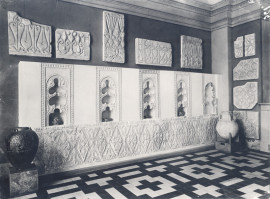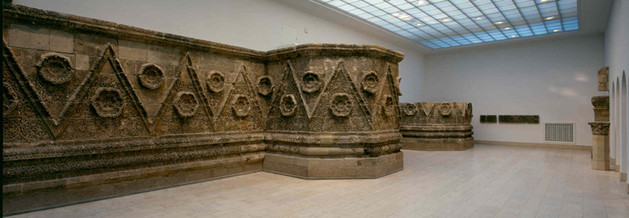Museum

Samarra-Saal, KFM, Museum für Islamische Kunst, Berlin
The Museum was founded in 1904 by Wilhelm von Bode as an Islamic department of the Kaiser Friedrich Museum (the current Bode Museum). Sparking the creation of the Museum was a gift from Ottoman sultan Abdul Hamid II to Kaiser Wilhelm II, namely the façade of the Umayyad desert palace of Mshatta. The palace façade, along with 21 carpets donated by Bode, formed the original basis of the collection. The museum moved into the newly built Pergamonmuseum, occupying the upper floor of its south wing; it opened there in 1932. The exhibition was closed in 1939 due to the Second World War.
During the war, artworks were removed from the museum building and stored elsewhere, although some objects remained in the Pergamonmuseum with attempts being made to safeguard them in place. Despite the efforts, the collection suffered damages and losses. An aerial bomb destroyed one the Mshatta façade’s gate towers, and an incendiary bomb burned valuable carpets wholly or partially that had been placed in the Mint’s vault for safekeeping. In 1954 the collection was reopened as the Islamic Museum in the Pergamonmuseum. The items that had been stored in the western occupation zones were handed over to the museum in Dahlem (in West Berlin), where, in 1954 as well, they were put on display for the first time since the war. From 1968 to 1970 there was an exhibition in Charlottenburg Palace. In 1971 the permanent exhibition of the Museum for Islamic Art was opened in a new building in the Dahlem museum complex.
In 1958 most of the artworks that had been taken to the Soviet Union as looted art in 1945 and 1946 were returned to the Islamic Museum in the Pergamonmuseum on the Museumsinsel. With the restoration of additional significant collection items, it was possible for all exhibition rooms to be made accessible to the public by 1967. Thanks to the German Unification Treaty, the two museums were organizationally merged in 1992 under the name of the Museum for Islamic Art. The exhibition in Dahlem closed in 1998. A newly configured permanent collection was opened in 2000 on the upper floor of the Pergamonmuseum’s south wing. From 23 October 2023, the collection will be closed for extensive renovation of the Pergamon Museum and will be reopened to visitors in the north wing from 2027 with new ways of presenting it to the public.

Mschattafassade, Museum für Islamische Kunst, Berlin; Inv.-Nr. I. 6163

FMIK e.V.
Latest
Contact
c/o Museum für Islamische Kunst
Geschwister-Scholl-Strasse 6
10117 Berlin
Phone: +49 (0)30 26642 5201
Email: info@fmik.de

-(1)._1900x500-c1s4q95.jpg)





